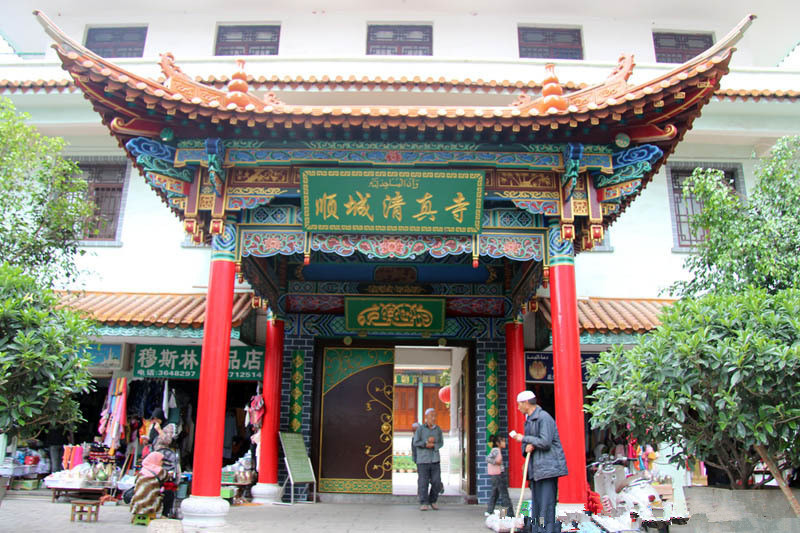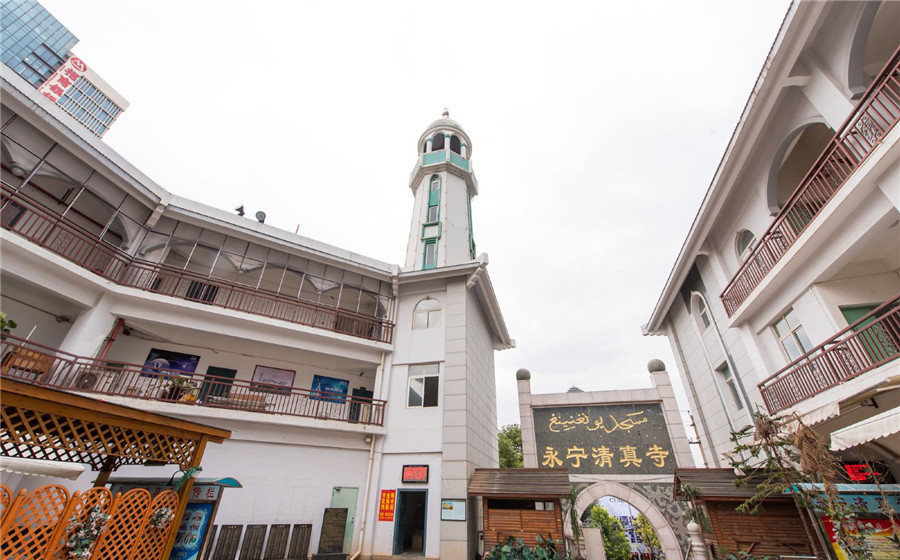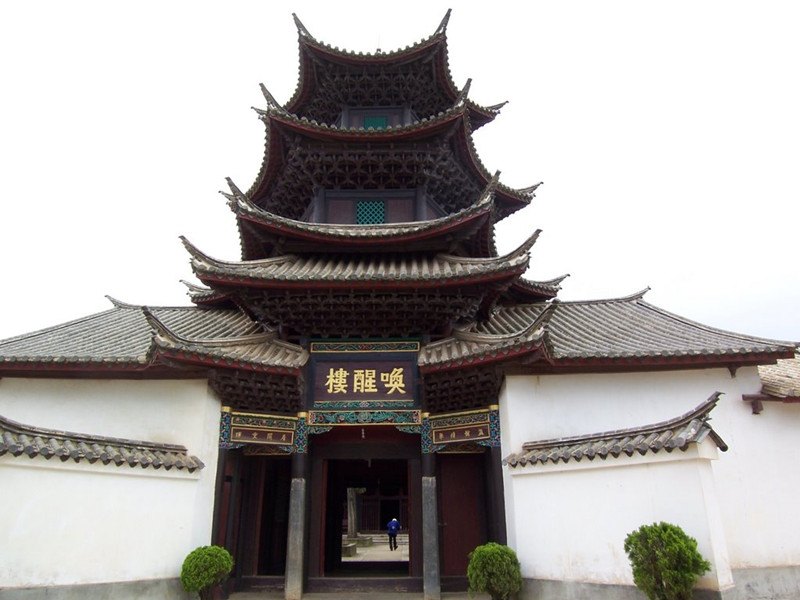
Top Muslim Mosques You Must Visit in Yunnan
Yunnan is a land of rich cultural diversity, home to numerous historic and architecturally unique mosques. Below is a recommended list of mosques suitable for international visitors, offering a detailed introduction from the perspective of promoting tourism in Yunnan:
Shadian Grand Mosque
Highlights:
- Largest Mosque in Southwest China: Covering 17,000 square meters and accommodating up to 10,000 worshippers simultaneously, it was funded by the local Hui Muslim community with an investment of 150 million yuan over five years. Known as “China’s Little Dubai.”
- Architectural Masterpiece: Blending Byzantine and Chinese palatial symmetry, the mosque features golden domes, four minarets, and grand arches. The interplay of sunset light through glass windows and marble flooring creates a sacred ambiance—especially breathtaking at night.
- Immersive Cultural Experience: Daily five-time prayers (e.g., Zuhr, Maghrib) can be observed from the periphery, offering a strong sense of religious devotion.
Travel Tips:
- Visiting Rules: Non-Muslims are not allowed inside the main prayer hall. Shoes must be removed; avoid loud noises, music, or Buddhist gestures.
- Photography Spots: Capture silhouettes along the side corridors during sunset or shoot the arches against the sky post-sunrise. Security staff often assist with photography tips.
- Transport: Around 2.5 hours’ drive from Kunming. Navigate to “Shadian Town, Gejiu City.” Free admission.
Shuncheng Street Mosque
Highlights:
- City Landmark: Built during the Ming Dynasty, it is the largest mosque in downtown Kunming. The prayer hall features a gabled roof with surrounding corridors, set in a tranquil garden-like environment amid urban hustle.
- Religious Function: Open for all five daily prayers. Over 900 attendees gather on Jumu’ah (Friday prayers), and nearly 2,000 during Eid festivals.
Travel Tips:
- Practical Info: Open from 6:30 AM to 11:30 PM. Free tea available. Nearby halal lodging and restaurants, such as “Ping’an Inn” and “Yunxiangzhai Bakery.”
Yongning Mosque
Highlights:
- Rich History: Originally built during the Yuan Dynasty, the current structure was rebuilt in 1898 (Guangxu period, Qing Dynasty). It follows a traditional siheyuan (courtyard) layout with a gabled wooden prayer hall and green glazed tile roof.
- Cultural Significance: Interior features a painting of the Hajj pilgrimage to Mecca. A major center for Islamic education in Yunnan.
Travel Tips:
- Visiting Time: Best visited during Eid to experience diverse cultural festivities.
- Nearby Attractions: Combine with visits to historical sites like Cuihu Park.
Tuogu Mosque
Highlights:

- Architectural Treasure: Established in 1730 (Yongzheng period, Qing Dynasty), famed for the “Awakening Tower”—a nail-free, all-wooden hexagonal three-eaved structure, 25 meters tall.
- Historical Records: Houses Qing Dynasty stone tablets documenting Hui people’s history and religious disputes.
Travel Tips:
- Transport: About 10 km by taxi from Ludian County. Alternatively, take a bus to Taoyuan Township, then walk 300 meters.
Najia Ying Mosque
Highlights:
- Architectural Fusion: Set among grey-brick homes, the mosque’s crescent domes, ornate arches, and geometric windows reflect exotic charm.
- Cultural Experience: Ideal for photography and architecture enthusiasts. Not a typical tourist town, so facilities are limited.
Travel Tips:
- Transport: 1.5-hour drive from Kunming, near Qilu Lake (杞麓湖).
Jianshui Mosque
Highlights:
- Chinese Temple Style: Diverging from Islamic domes, it features traditional Chinese double-eaved gateways, wooden carvings, and wind chimes. Inscribed with “Patriotism is Part of Faith.”
- Tranquil in the Bustle: Nestled in Jianshui Old Town near museums and halal eateries, ideal for exploring Hui-Han cultural coexistence.
Travel Tips:
- Free Entry: Combine with visits to Jianshui Old Town (Zhu Family Garden, Confucian Temple), spend around 30 minutes here.
- Cultural Sensitivity: Avoid mentioning pork; respect dietary restrictions.
Qudong Ancient Town Mosques
Highlights:
- Largest Muslim Settlement in Western Yunnan: Two mosques coexist—an elegant 1913 mosque and a modern white hilltop mosque (built 2006), connected by stone steps with panoramic town views.
- Living Cultural Heritage: Preserves Tea Horse Road history. Alley murals feature Arabic scripts and Muslim daily life. The Eid cemetery procession is especially unique.
Travel Tips:
- Deep Cultural Immersion: Join daily prayers or explore local hot springs and specialties (e.g., braised chicken).
- Transport: 1.5-hour drive from Dali to Qudong Village, Yongping County.
Huihuideng Mosque
Highlights:
- Historic and Cultural Fusion: Originally built in the late Qing Dynasty, expanded in 1921. Its four-story minaret and prayer hall hold over 1,000 people. Interior carvings blend Chinese and Islamic aesthetics.
- Folk Experiences: Join the Hui “Three-Course Tea” ceremony, and visit the Caravan Culture Museum for a glimpse of Tea Horse Road traditions.
Travel Tips:
- Transport: Easily accessible by car from Dali.
Keli Village Mosque
Highlights:
- Historical and Cultural Fusion: A historic and finely built Muslim place of worship, integrating traditional Chinese and Islamic architectural styles.
- Peaceful Visit: Ideal for quiet reflection during a tour of Dali.
Travel Tips:
- Transport: Located in Dali City, convenient to combine with a visit to Dali Old Town.
Jinniu Street Mosque
Highlights:
- Historical Significance: Built during the Yuan Dynasty, one of Yunnan’s oldest mosques. Home to the world’s only wooden carved Arabic Qur’an, dubbed a “Living Fossil of Chinese Islamic Culture.”
- Chinese Courtyard Style: Traditional courtyard layout with a gabled prayer hall. Mecca-themed murals adorn the walls.
Travel Tips:
- Nearby Experiences: Next to Shuncheng Street food district. Sample halal Yunnan snacks like cold rice noodles and grilled erkuai to enjoy local vibes.
Visitor Guidelines
- Etiquette: Remove shoes before entering prayer halls; maintain silence. Women should dress modestly. Some mosques may require headscarves (bring your own or borrow on-site).
- Timing: Avoid entering during prayer times (five daily). Observation from courtyards is acceptable. Friday Jumu’ah (12:00–14:00), Eid al-Fitr, and Eid al-Adha offer rich experiences but attract large crowds.
- Respect the Culture: Non-Muslims are generally not permitted inside prayer areas. Avoid photographing worshippers’ faces and disable flash.
- Transport Suggestions: Destinations like Shadian and Najia Ying are best accessed by car.

 7 Days GolfingTour
7 Days GolfingTour
 8 Days Group Tour
8 Days Group Tour
 8 Days Yunnan Tour
8 Days Yunnan Tour
 7 Days Shangri La Hiking
7 Days Shangri La Hiking
 11 Days Yunnan Tour
11 Days Yunnan Tour
 6 Days Yuanyang Terraces
6 Days Yuanyang Terraces
 11 Days Yunnan Tour
11 Days Yunnan Tour
 8 Days South Yunnan
8 Days South Yunnan
 7 Days Tea Tour
7 Days Tea Tour
 8 Days Muslim Tour
8 Days Muslim Tour
 12 Days Self-Driving
12 Days Self-Driving
 4 Days Haba Climbing
4 Days Haba Climbing
 Tiger Leaping Gorge
Tiger Leaping Gorge
 Stone Forest
Stone Forest
 Yunnan-Tibet
Yunnan-Tibet
 Hani Rice Terraces
Hani Rice Terraces
 Kunming
Kunming
 Lijiang
Lijiang
 Shangri-la
Shangri-la
 Dali
Dali
 XishuangBanna
XishuangBanna
 Honghe
Honghe
 Kunming
Kunming
 Lijiang
Lijiang
 Shangri-la
Shangri-la
 Yuanyang Rice Terraces
Yuanyang Rice Terraces
 Nujiang
Nujiang
 XishuangBanna
XishuangBanna
 Spring City Golf
Spring City Golf
 Snow Mountain Golf
Snow Mountain Golf
 Stone Mountain Golf
Stone Mountain Golf



















